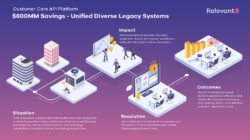Financial Technology Services Firm
Card Payment Processing Platform
Legacy to Distributed Architecture Solution
Situation
The payment processing workflow interacts with a multitude of interfaces and subsystems. This entire workflow was running within mainframe infrastructure, handling all the orchestration between the interfaces and subsystems, hence complicating the primary workflow itself and causing many challenges:
- The client had higher operational costs, as its primary workflow was bloated with orchestration responsibilities utilizing high MIPS
- The underlying complexity and lack of talent pool in assembler programs led to delays in developing and releasing new features and functions to its customers
- Any solution could not compromise the SLA agreements of payment processing, in terms of throughput, availability, and performance
Impact
- Due to the inherent complexity of the bloated workflow, the client was not able to meet the customer expectation of releasing features and functionalities on time, resulting in unhappy customers
- The client was leaving potential revenue on the table by not having the features and functionalities the customers were ready to pay for
- The client was not able to innovate and be the leader in the market and was forced to play catch-up with the competition, especially with the innovative and cost-effective Fintech industry solutions
Resolution
We architected and developed a distributed messaging orchestrator solution that bridges the application services running between the mainframe and distributed environments. The messaging orchestrator handles many protocols and data formats, translating the request and response between subsystems, thereby relieving the primary payment processing workflow of such responsibilities. This enabled:
- Subsystems to run in cheaper distributed technology and infrastructure, leading to MIPS reduction per transaction
- Rapid release of new subsystem-level features and functionalities to the market, resulting in greater customer satisfaction
- The client to stay competitive with innovation, leveraging the abundant talent pool available on modern technology stacks
Outcomes
For a leading payment processing firm, we architected and developed a distributed architecture solution to bring commodity infrastructure-based computing to work along with its existing mainframe infrastructure-based computing, enabling the client to:
- Migrate application services running in expensive mainframe infrastructure to less expensive commodity servers
- Release new features and functions to the customers faster than ever
- Mitigate the challenge of lack of talent pool in the market on mainframe technology

